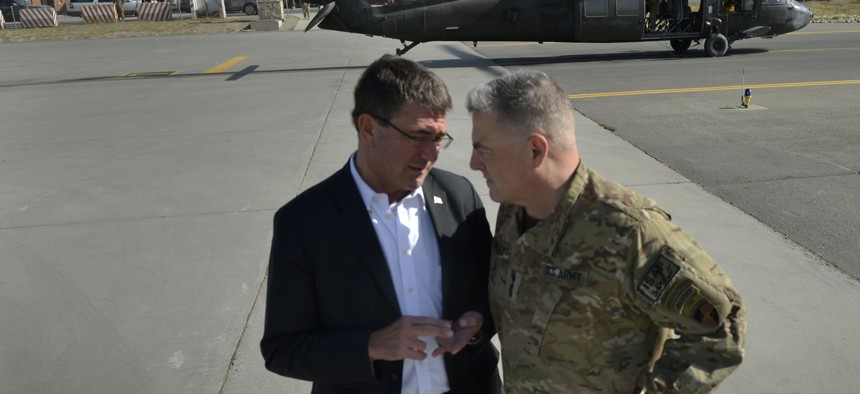
Then-Deputy Defense Secretary Ashton Carter talks with then-Lt. Gen. Mark Milley in Kabul, Afghanistan, on Sept. 16, 2013. Glenn Fawcett/Defense Department
Carter Crafts Close Team of Chiefs to Finish Out Obama Years
Defense Secretary Ashton Carter’s team is finally coming together, but they don’t have much time to accomplish several ambitious projects.
With a background that includes infantry command and Special Forces, Gen. Mark Milley on Friday will become 39th Army chief, taking over for Gen. Raymond Odierno, perhaps the most outspoken military general in recent years. Milley is more than qualified for the job. But the personal bond he formed with Defense Secretary Ashton Carter years ago on a flight over Afghanistan certainly helped.
“I had a lot of opportunities to observe Mark on the ground leading our coalition of allies and partners and helping the Afghan people prepare to take responsibility for their own security,” Carter said as he announced Milley's nomination in May.
Carter recounted a trip with Milley to Herat, Afghanistan, the day after an attack on the U.S. consulate. There he watched Milley “take command of the scene.”
“I was impressed by his candor and good judgment, and I knew right away that he had even more to offer to the United States Army,” Carter said.
The personal relationships and bonds forged between Carter and senior military leaders over the years shaped his recommendations to President Barack Obama as the nation's top uniformed positions opened up.
With Milley, there was that flight in Afghanistan. With Marine Corps Lt. Gen. Robert Neller, whom Carter would recommend as commandant, there were meetings at the Pentagon meetings. Navy Adm. John Richardson, like Carter, holds a bachelor's degree in physics. Now he is nominated to be the next chief of naval operations.
Marine Gen. Joseph Dunford and Air Force Gen. Paul Selva are considered two of the most strategic thinkers in the military. “We saw in them the same strategic perspective, operational experience, sound judgment, and total candor we value every day in our current leadership,” Carter said of Dunford and Selva, after he nominated them in May.
Becoming defense secretary during the latter stages of Obama’s second term means Carter has mere months —17 to be precise — to make an impact. That’s why he has surrounded himself with a familiar core of analytically minded leaders, several defense and military officials say.
“He needs people that he knows how they think, how they operate, already,” one defense official said.
And it’s not just on the uniformed side. When Carter needed an Army undersecretary, he chose a known quantity in Eric Fanning, his chief of staff. A former Air Force undersecretary, Fanning was the service’s acting secretary for several months before Secretary Deborah Lee James was confirmed. It is widely believed Fanning quickly will be tapped to replace Army Secretary John McHugh, who has announced he will retire in November.
Such relationships ought to allow these leaders to hit the ground running in their new jobs, allowing more time to work through Carter’s to-do list, Pentagon sources say. Carter has laid out a bold agenda, from personnel reforms through his Force of the Future initiative to trying to better relations between the Pentagon and tech community.
With the exception of the Air Force, timing has allowed Carter to hand-pick a new chairman and vice chairman of the Joint Chiefs and the military heads of the Army, Navy and Marine Corps. He’ll also pick a new Army secretary in the coming months.
The Senate, in a matter of months, has confirmed all of the men selected for the top military positions with little drama throughout the process.
Selva, an Air Force cargo pilot, has already taken his seat in the Pentagon in a low-key Friday ceremony two weeks ago. There was no fanfare, no press conference, just a few pictures posted on Carter’s Flickr account.
There’s Neller, with whom Carter bonded on the battlefield and at the Pentagon in 2011 and 2012 where they worked together on projects to get those who were deployed essential equipment. At the time, Neller was the Joint Staff’s director of operations and Carter was the deputy defense secretary.
“We collaborated in the Warfighting Senior Integration Group, where we focused on providing urgent support to troops in the field in both Iraq and Afghanistan,” Carter said at Neller’s nomination announcement in May.
“[W]e traveled together, [in] the theater, around this country, where I saw Bob's outstanding relationship with our troops,” Carter said. “He loves them, he relates to them, and they light up when he's talking to them.”
Finally there’s Richardson, the head of the Navy’s nuclear programs who is the next chief of naval operations. Carter has called Richardson “a bold thinker, a tremendous leader, and the go-to officer for many of the Navy's tough issues in recent years.”
In the coming weeks, these men will take their seats inside the Pentagon. Most will likely remain when Carter is likely to depart in early 2017. Whether they can enact his reforms before then remains to be seen. Many of the ideas would require congressional approval — no sure thing as the presidential race heats up.




